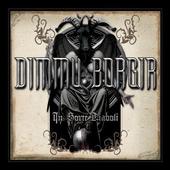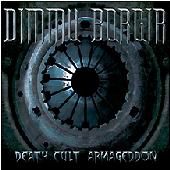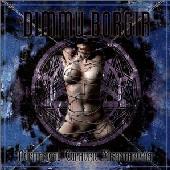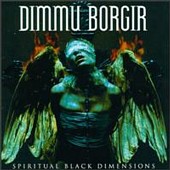|
|
|
|
|
|
![]()
DIMMU BORGIR
![]()
"In Sorte
Diaboli" (Nuclear Blast; 2007)![]()
![]()

Reviewed by Jeff Rogers



![]()
Dimmu Borgir means "Dark Cities" or "Dark Fortress" in Icelandic. These guys are from Oslo, Norway which is the black metal capital of the world, so who would disagree? This release was printed with a special boxed case with backwards lyrics and a mirror.
The album name literally means "In Direct Contact With
Satan." This is the seventh studio CD from Dimmu Borgir and marks their first
attempt at a concept album. Another first is that this disc reached the Number
One spot on Billboard and became the first black metal album to ever do so. \m/
to you!!
Now let's get to the hanging meat: The symphonic black sound of Dimmu Borgir is
creepy, with devil screams and the sinister growls of Shagrath, this disc makes
for one brutal ride. The story is about a priest who doubts his faith and then
takes the place of the Antichrist. The track titled "The Fallen Arises" is an
instrumental gift and marks the halfway point in the story before "The Heretic
Hammer" falls upon you.
I've listened to a few black metal bands and they
almost always made me laugh at the notion of their goofy attempt to portray
followers of El Diablo. Dimmu Borgir put so much into their approach of telling
a story that you feel like you are listening to a black metal opera but you are
stuck outside with front row tickets clutched within your sweaty palms. Their
whole loom of drawing you in is melodic and you can pretty much come within
reach of their passion.
This isn't some weekend gig for them. Their attitude behind the music and story
telling is methodical and almost too much to handle for the novice listener. For
those who dove into the story save some room for the rest of the tale. Rumor is
that this isn't over and the next six albums will continue and finish this as a
six part series.
Dimmu Borgir: Shagrath – vocals; Silenoz – guitars;
inside story; Galder – lead guitar; Mustis – synthesizers; I.C.S. Vortex – bass
guitar, clean vocals (on track 1, 5 and 10); Hellhammer – drums.
For more information, check out
http://www.dimmu-borgir.com/ or
http://www.myspace.com/dimmuborgir.
![]()
"Death
Cult Armageddon" (Nuclear Blast; 2003)![]()

![]()
Reviewed by Christopher J. Kelter




Well, it appears I've committed a cardinal sin of critical music reviewing: I overplayed Dimmu Borgir's latest effort, "Death Cult Armageddon," before writing about it and thus became too familiar with it and losing any shred of objectivity I might have had. Oh, well -- call it a semi-occupational hazard.
Dimmu Borgir have forged a long and arduous path with their career. Granted, Dimmu Borgir are inching more and more closely to being the prime commercial black metal band -- a great, or not so great, honor depending on who you talk to. Some would say that Cradle Of Filth deserves the honor more than these Norwegians, but I beg to differ. Sure, Cradle Of Filth have appeared on OzzFest and are now on a major label, but although I like Cradle Of Filth's "Damnation And A Day" better than their previous releases, the English masters of black metal still do not hold a candle to Dimmu Borgir in my opinion.
Dimmu Borgir are still a band driven by ambition. In the case of "Death Cult Armageddon" Dimmu Borgir take ambition in the form of the classical elements introduced on their previous album "Puritanical Euphoric Misanthropia" -- this time Dimmu Borgir incorporate classical instruments into the band's musical tapestry in grand sweeping arcs of dark mystery. Instead of using just an ensemble, Dimmu Borgir incorporate an entire orchestra into "Death Cult Armageddon."
Overall, "Death Cult Armageddon" lacks some of the intensity of band's previous releases, yet manages to inject the same power in the band's performance. Scaling new creative heights must seem like an ordinary task for Dimmu Borgir as every track seems to shed new light on the creative abilities of the band. Every track brims with creativity and the sound that no stone was left unturned in creating a masterpiece.
Some interesting observations in no particular order: 1) the beginning of "Blood Hunger Doctrine" sounds as if Dimmu Borgir is trying to fill the gap left by the absence of Samael and the classic sound the Swiss masters created with "Passage"; 2) just like Dimmu Borgir's old days, two of the album's eleven tracks are sung in the band's native Finnish tongue -- in fact, "Allehelgens Dod I Helveds Rike" is one of my favorite tracks from the album; 3) the trio of near-epics that close the disc are stunning works of black metal; and 4) oddly, the artwork for "Death Cult Armageddon" is strangely reminiscent of Megadeth's "Countdown To Extinction."
Already exalted among the black metal elite (commercial or otherwise), "Death Cult Armageddon" will raise the stature of Dimmu Borgir even further.
"Death Cult Armageddon" was produced by Dimmu Borgir and Fredrik Nordstrom. It goes without saying that the production on "Death Cult Armageddon" is one of the disc's highlights.
Dimmu Borgir: Shagrath on vocals, Silenoz on guitars, Galder on lead guitars, Vortex on bass and clean vocals, Mustis on keyboards, and Nick Barker on drums. All orchestration provided by the Prague Philharmonic Orchestra.
For more information visit http://www.dimmu-borgir.com.
![]()
"Puritanical
Euphoric Misanthropia" (Nuclear
Blast; 2001)![]()

![]()
Reviewed by Christopher J. Kelter



![]()
Dimmu Borgir's "Spiritual Black Dimensions" will forever hold a special place for me in my metal experience as it was the first CD that actually made me believe that I could like black metal. Some people dis Dimmu Borgir for being too slick and too commercial -- to that I say don't let it hold you back from hearing a band who are masters of their craft.
"Puritanical Euphoric Misanthropia" is book-ended by two haunting instrumental tracks: "Fear And Wonder" is the calm before the storm and "Perfection Or Vanity" is the release from the carnage that makes up the substance of the record. "Blessings Upon The Throne Of Tyranny" barks out wretched disdain for those who morally judge others and sets the tone for the rest of the album. Dimmu Borgir's infusion of classical music is most evident on "Hybrid Stigmata -- The Apostasy" with its alternating moments of intensity and brief respites as though the works of Wagner and Stravinsky were cut and pasted together. "Puritania," a last minute recording, plows sacred ground by dropping grandeur for a more staccato approach which splits the CD effectively in half. "The Maelstrom Mephisto" blasts away at all that is good in your soul -- it's an assault on purity like no other. "Absolute Sole Right" describes the uncertainly of life through the diametric opposites of good and evil, order and chaos, the simple and the complex.
In the early going I wasn't so convinced of the prevalence of classical orchestration on "Puritanical Euphoric Misanthropia," but after repeated listens classical orchestration is all over the CD and it raises the sound of the CD to great heights. The classical orchestration was recorded by an ensemble, not a full orchestra.
The usual anti-Christian sentiments are all over "Puritanical Euphoric Misanthropia," but in a more opaque sense than previous recordings. Even though Dimmu Borgir have dropped corpsepaint, the band keeps their fiendish and devilish image intact.
The addition of Nicholas Barker in the drum seat has done wonders for Dimmu Borgir's sound. After a few listens I'm not convinced I prefer Galder over Astennu, but Galder is a great guitarist in his own right. Vortex is highly desired on any CD and his clean vocals continue to add depth and color to Dimmu Borgir -- in fact, I believe Dimmu Borgir should expand Vortex's clean vocals in future recordings. Silenoz is a creative force and Mustis utilizes a myriad of sounds to tie the Dimmu Borgir style together. Shagrath is seemingly made for the commercial black metal sound that Dimmu Borgir has popularized.
"Puritanical Euphoric Misanthropia" was produced by Fredrik Nordstrom. The production values are phenomenal and the music is crystal clear even when the density reaches near overwhelming proportions.
Dimmu Borgir is Shagrath on vocals and synthesizers, Silenoz on guitars, Galder on lead guitars, Vortex on bass, Mustis on keyboards, and Nicholas Barker on drums.
For more information visit http://www.dimmu-borgir.com.
![]()
"Puritanical
Euphoric Misanthropia" (Nuclear
Blast; 2001)![]()

![]()
Reviewed by J. Kennedy



![]()
Following what some called the lackluster
"Spiritual Black Dimensions" (which I found to be just fine) the black metal act
"Dimmu Borgir" decided to incorporate more orchestration into their already complex
arrangements. This may have alienated quite a few of their hardcore following. The band seemed to be leaving their black metal
roots behind in favor of a more mainstream sound. How wrong could some people be? Very
wrong, on the evidence of this fantastic record.
The opening instrumental, "Fear & Wonder," would be at home on the soundtrack
to the latest "Lord Of The Rings" blockbuster. However, it is welcome here
as well and that fact does nothing but show how talented Dimmu crew are at
arrangement. An interesting note: The orchestration here is performed by the Gothenburg Opera Orchestra and has actually encouraged me to listen to more
classical music pieces. Who says metal is for dummies?
New sticksman Nicholas Barker (formerly of Cradle Of Filth and Lock Up) and new axeman
Galder (formerly of Old Man's Child) fit in well and serve to add a new direction to the music. Barker allows more room for the
orchestration to breathe while still being able to provide brutal drumbeats in an instant.
Shagrath manages to switch between some punishing black metal screams and
some pretty effective OTT vocals. This works to good effect and shows his range as a vocalist.
Several tracks to check out before buying would be the awesome "Hybrid Stigmata - The
Apostacy" and the very straight forward "Puritania."
This CD is recommended as a starting point for those new to Dimmu Borgir.
Dimmu Borgir: Shagrath, Galder, Erkekjetter Silenoz, Mustis, Nicholas Barker, Simen
Hestnaes.
Find out more about Dimmu Borgir at: www.dimmu-borgir.com.
![]()
"Spiritual Black Dimensions" (Nuclear
Blast; 1999)
![]()
![]()
Reviewed by Christopher J. Kelter



![]()
Dimmu Borgir are Norwegian black metal masters;
"Spiritual Black Dimensions" should appeal to those that like their music with
extremely raging passages, overwhelming doses of gothic keyboards, and frenetic drums.
Dimmu Borgir are almost as good as Emperor; the differences between these two bands
are nearly negligible. What distinguishes Dimmu Borgir from their black metal
counterparts is their ability to sustain their turbulent sonic attack without losing the
interest of the listener.
More traditional heavy metal guitar parts can be found in songs "United In Unhallowed
Grace," "The Insight And The Catharsis," and Grotesquery Conceiled."
Dimmu Borgir's ability to flesh out fluid passages is evident in songs like
"Dreamside Dimensions," "The Promised Future Aeons," and "Arcane
Lifeforce Mysteria." Songs like "The Blazing Monoliths Of Defiance" and
"Reptile" demonstrate the band's ability to craft songs that display a penchant
for speed and melody.
The vocals are colossal in their scope; every metal style is utilized to convey a broad spectrum of mysterious presence, hallowed spirits, earthly horrors, and demonic tales. Each song has an immediately defining characteristic all the while weaving guitars and keyboards into a maelstrom of grand proportions. Silenoz and Astennu may be the best guitar duo in metal today.
Admittedly, Dimmu Borgir is not for everyone. However, for those brave enough to sample the black metal style there's no doubting that "Spiritual Black Dimensions" is a good place to start. The experience will leave you simultaneously energized and emotionally depleted.
"Spiritual Black Dimensions" was produced by the legendary Peter Tagtgren of Hypocrisy at his studio (Abyss). Dimmu Borgir also gets co-production credit. The sound is very full and thick without detrimentally taking away from the overall experience. Dimmu Borgir have set a very high standard for themselves (and others) with "Spiritual Black Dimensions."
Dimmu Borgir are Shagrath on vocals, Silenoz on rhythm guitars, Astennu on lead guitars, Nagash on bass guitar, Tjodalv on drums, and Mustis on keyboards. Additional clean vocals and bass, courtesy of Simen Hestnaes (known as ICS Vortex in his full-time band Borknagar).
For more information visit http://www.dimmu-borgir.com/ which is the band's official website.
![]()
"Godless Savage Garden" (Nuclear
Blast; 1998)
![]()
![]()
Reviewed by Christopher J. Kelter



"Godless Savage Garden" is a mix of two re-recorded tracks, three live tracks,
two new tracks, and a cover of a metal classic. Dimmu Borgir released this package to help
tide fans over for the wait between the full length CDs "Enthrone Darkness
Triumphant" and "Spiritual Black Dimensions." Dimmu Borgir's music is like
the constellations that appear with the encroaching night - it envelopes your senses in a
cloak of darkness.
The two re-recorded tracks sound great, but are clearly show the band's embryonic
development in the mid '90s (when these tracks were originally done).
"Hunnerkongen" is by no means a great song, but it does carve an interesting mix
of American death metal a la Slayer, but with the hints of the gothic elements later added
to the band's growing and stirring sound. "Raabjorn Speiler Draugheimens Skodde"
is most impressive as it mixes tempos and moods to lasting effect; this song also hints at
the band's eventual growth in developing songs with complex structures. Both tracks can be
found in their original versions on "For All Tid."
The two new tracks are solid songs that begin to show the band's willingness to let keyboards be the foundation of their melodic black metal sound. "Moonchild Domain" and "Chaos Without Prophecy" are closest in spirit and style to the near perfect full length CD "Spiritual Black Dimensions" that would soon follow in 1999.
The live tracks are "Stormblast," "Master Of Disharmony," and "In Death's Embrace." Both "Master Of Disharmony" and "In Death's Embrace" can be found on the band's sophomore disc "Enthrone Darkness Triumphant"; easily the best live track of the three is "In Death's Embrace."
The cover song is Accept's "Metal Heart." The intriguing element of this choice is that it is ripe for interpretation. Dimmu Borgir's version is a fairly faithful rendition, yet at a quicker pace. Shagrath's voice is very interesting to hear over the familiar riffs, but does a credible job of recreating the spirit of Udo's delivery without abandoning the Dimmu Borgir sound.
Once again, Dimmu Borgir enlisted Peter Tagtgren's (of Hypocrisy) production assistance; Tagtgren's Abyss studio was used as well.
Dimmu Borgir is Shagrath on vocals, Astennu on lead guitars, Silonez on rhythm guitars, Nagash on bass, and Tjodalv on drums.
For more information visit http://www.dimmu-borgir.com/ which is the band's official website.
![]()
Rating Guide:



 A classic. This record will kick your ass.
A classic. This record will kick your ass.


 Killer. Not a classic but it will rock your world.
Killer. Not a classic but it will rock your world.

 So-so. You've heard better.
So-so. You've heard better.
 Pretty bad. Might make a nice coaster.
Pretty bad. Might make a nice coaster.
![]() Self explanatory. Just the sight of the cover makes you wanna hurl.
Self explanatory. Just the sight of the cover makes you wanna hurl.
![]()
Copyright © 2009 by R. Scott Bolton. All rights
reserved.
Revised:
03 Feb 2025 12:19:23 -0500.
